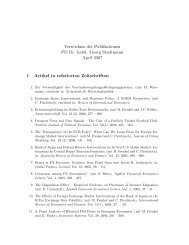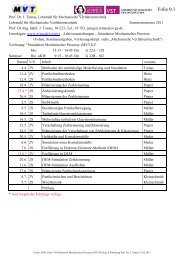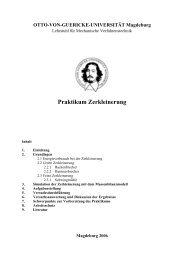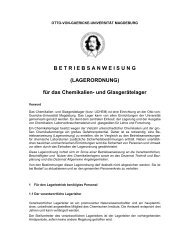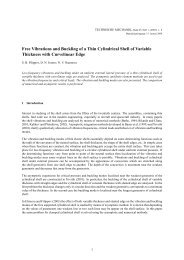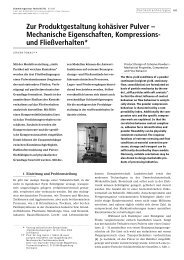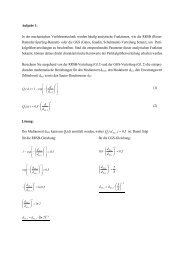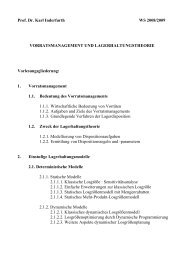10J. TomasFigure 1. Characteristic spherical particle contact deformation. (a) Approach and (b) elastic contactdeformation (titania, primary particles d = 20–300 nm, surface diameter d S = 200 nm, median particlediameter d 50,3 = 610 nm, specific surface area A S,m = 12 m²/g, solid density ρ s = 3870 kg/m 3 , surfacemoisture X W = 0.4%, temperature θ = 20°C) [148]. Pressure and compression are defined aspositive but tension and extension are negative. The origin <strong>of</strong> this diagram (h K = 0) is equivalent tothe characteristic <strong>adhesion</strong> separation for direct contact (atomic center to center distance), and canbe estimated for a molecular force equilibrium a = a 0 = a F=0 . After <strong>approach</strong>ing from an infinite distance–∞ to this minimum separation a F=0 the sphere–sphere contact without any contact deformationis formed by the attractive <strong>adhesion</strong> force F H0 (the so-called “jump in”). Then the contact maybe loaded F H0 – Y and, as a response, is elastically deformed with an approximate circular contactarea due to the curve marked with Hertz (panel b). The tensile contribution <strong>of</strong> principal stresses accordingto Huber [42] at the perimeter <strong>of</strong> contact circle is neglected for the elliptic pressure distribution,drawn below panel b.
<strong>Mechanics</strong> <strong>of</strong> <strong>nanoparticle</strong> <strong>adhesion</strong> — A <strong>continuum</strong> <strong>approach</strong> 11area on the principal axis r 2 2 2K= x + y = 0 in the depth <strong>of</strong> z ≈ r K,el /2. Combiningthe major principal stress distribution, Eq. (9), σ 1 = σ z (z) at contact radius r K = 0max2rKel2 2+Kel ,σz ( z ) ,=p r zand the minor principal stress, Eq. (10), σ 2 = σ y = σ t (z) [42]KK,el, (9)2t( z) 1rKel, rKel,=− ⋅ +2 2( 1+ ν ) ⋅ 1 z arctanmax2 − ⋅r ≤r rKel,zK,elσp r z , (10)+ the maximum shear stress inside a particle contact r K ≤ r K,el is obtained using theτ = σ − σ [1]:Tresca hypothesis for plastic failure ( )KK,elmax 1 222( z) 3rKel, 1 ν rKel,= ⋅ − + ⋅ 1 z arctan2 2max4 2 − ⋅r ≤r rKel,zK,elτp r z + (11)This internal shear stress distribution becomes more and more critical for ductileor s<strong>of</strong>t solids with a small transition to yield point, and consequently, plasticcontact deformation like <strong>nanoparticle</strong>s with very low stiffness, see Section 2.3.Due to the parabolic curvature F N (h K ), the particle contact becomes stiffer withincreasing diameter r 1,2 , contact radius r K or displacement h K (k N is the contactstiffness in normal direction):dFk = = E ⋅ r ⋅ h = E ⋅ r(12)N * *N dh12 , K KKThe influence <strong>of</strong> a tangential force in a normal loaded spherical contact wasconsidered by Cattaneo [46] and Mindlin [47, 63]. About this and complementarytheories as well as loading, unloading and reloading hysteresis effects, one canfind a detailed discussion by Thornton [53]. He has expressed this tangential contactforce as [53, 54]:( )*4 ψ δ 1 ψ tanϕT 12 , K i NF = ⋅ ⋅G ⋅ r ⋅h ⋅∆ ± − ⋅ ⋅∆ F(13)Here ∆δ is the tangential contact displacement, ψ the loading parameter dependenton loading, unloading and reloading, ϕ i the angle <strong>of</strong> internal friction,G= E 2 1+ ν the shear modulus, and the averaged shear modulus is given as:( )* 2– ν1 2–ν2G = 2⋅ +G1 G 2 – 1(14)



